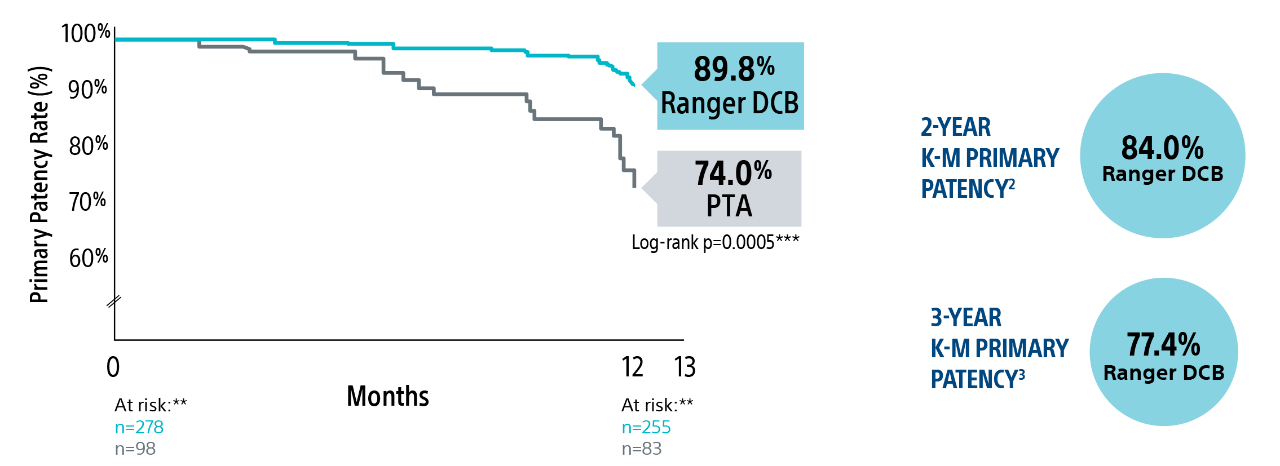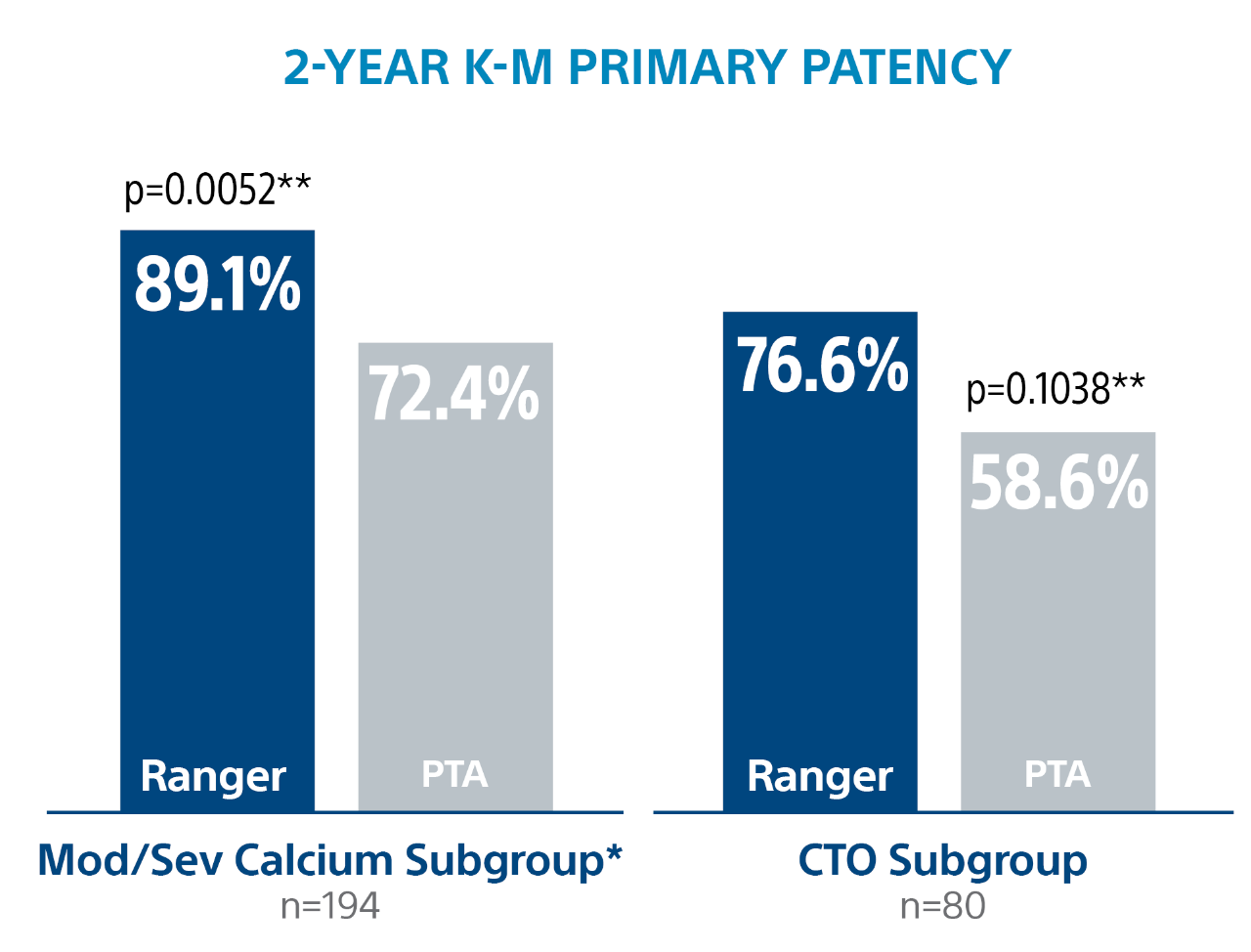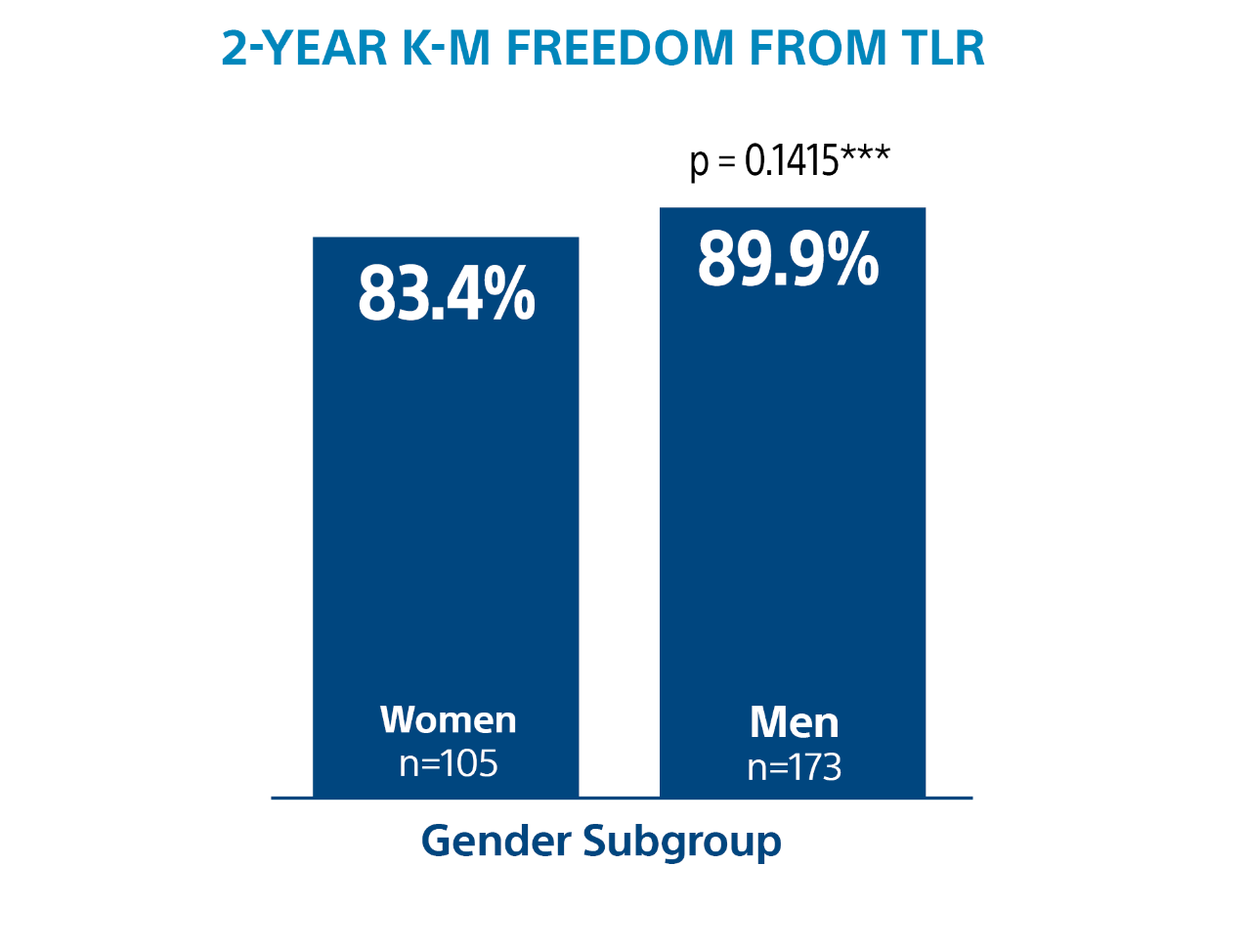RANGER II SFA pivotal trial
Prospective, Multi-Center, Randomized Controlled Trial Ranger Drug-Coated Balloon vs. Uncoated Balloon (3:1). Follow-up through 5-Years.1
Ranger DCB demonstrated exceptional patency outcomes at 1, 2 and 3 years.
1-YEAR K-M PRIMARY PATENCY rates K-M Estimate¹*

* Kaplan-Meier Estimate: Primary patency as determined by duplex ultrasound (DUS) Peak Systolic Velocity Ratio (PSVR) is ≤2.4 at the 12-month follow-up visit, in the absence of clinically driven TLR or bypass of the target lesion.
** At risk denotes the number of subjects entered in the calculation at the time interval.
*** Logrank p-value compares the entire K-M curves from time zero to full 1-year follow-up.
Ranger DCB demonstrated durability, with low reintervention rates through 5 years
K-M FREEDOM FROM CD-TLR
94.5% at 1-Year†
More than 9 in 10 patients did not need reintervention at 1 year
76.9% at 5-years‡
Nearly 8 in 10 patients did not need reintervention at 4 years
†Subjects at risk at day 365=198 subjects
‡Subjects at risk at day 1825=68 subjects
2-year subgroup analysis
Ranger DCB delivered exceptional outcomes in complex lesions at 2-Years.

Ranger DCB demonstrated low reintervention rates regardless of patient gender.

* PACSS Grade 3/4 Calcification
** Log-rank p-value compares the entire K-M curves from time point zero to day 760 (full 2-year follow-up window)
*** Log-rank p-value compares the entire K-M curves from time point zero to day 730 (full 2-year annual visit mark)
Ranger II SFA pivotal trial details
- 1-year primary endpoint results
- Baseline patient & lesion characteristics
| Ranger DCB (n=207) | PTA (n=98) | p-value | |
|---|---|---|---|
| Primary safety endpoint (Freedom from MAE) | 94.1% (241/256) | 83.0% (76/91) | P non-inferiority ‹0.0001 |
| Primary effectiveness endpoint (Binary primary patency) | 82.9% (194/234) | 66.3% (57/86) | 0.0017 |
| Ranger DCB (n=278) | PTA (n=98) | p-value | |
|---|---|---|---|
| Age (year) | 70.6 | 69.1 | 0.1887 |
| Women | 37.8% | 31.6% | 0.2769 |
| Smoking history | 0.0303 | ||
| Current/previous | 31.3% / 54.0% | 45.9% / 38.8% | N/A |
| Never/unknown | 14.4% / 0.4% | 15.3% / 0.0% | N/A |
| Diabetes mellitus | 42.4% | 43.9% | 0.8055 |
| Lesion length (mm) | 82.5 | 79.9 | 0.655 |
| Moderate calcium (PACSS grade 3) | 36.3% | 52.0% | 0.006 |
| Severe valcium (PACSS grade 4) | 11.5% | 10.2% | 0.724 |
| 100% (occlusion) | 18.3% | 29.6% | 0.019 |
- 1-year key results¹
- 2-year key results²
- Key long-term results³ʼ⁴
| Ranger DCB (n=278) | PTA (n=98) | p-value | |
|---|---|---|---|
| CD-TLR | 5.5% | 16.5% | 0.0011 |
| K-M All-Cause Mortality | 1.9% | 2.1% | 0.8794* |
| Ranger DCB (n=278) | PTA (n=98) | p-value | |
|---|---|---|---|
| K-M Freedom from TLR | 87.4% | 79.5% | 0.0316* |
| Mod/Sev Calcium Subgroup K-M Freedom from TLR | 90.9% | 79.6% | 0.0246* |
| CTO Subgroup K-M Freedom from TLR | 85.6% | 62.8% | 0.0172* |
| All-Cause Mortality | 5.7% | 3.2% | 0.4218 |
| Ranger DCB (n=278) | PTA (n=98) | p-value | |
|---|---|---|---|
| 3-year results | |||
K-M Primary Patency | 77.4% | 73.5% | 0.2555* |
| 5-year results | |||
All-Cause Mortality | 15.8% (44/278) | 20.4% (20/98) | 0.2995 |
K-M Freedom from CD-TLR | 76.9% | 74.8% | 0.3715* |
Major Amputation | 0.5% | 0.0% | 1.0000 |
* Log-rank p-value
1 RANGER II SFA RCT 1-Year Results published in JACC:CI. doi.org/10.1016/j.jcin.2021.03.021
2 RANGER II SFA RCT 2-Year Results presented by Ravish Sachar, MD. VIVA 2021
3 Latest RCT update presented by Marianne Brodmann, MD at LINC 2023, Tuesday 06-June Main Arena 1 09:45 – 09:50
4 Latest RCT update presented by Marianne Brodmann, MD at LINC 2024
Primary safety endpoint: composite of freedom from device and procedure-related death through 30 days and freedom from major target limb amputation and CD-TLR through 1-Year post index-procedure.
Primary efficacy endpoint: primary patency at 1-Year defined as absence of clinically driven target lesion revascularization (CD-TLR) or binary restenosis determined as a peak systolic velocity ratio > 2.4 evaluated by duplex ultrasound core laboratory analysis.
CD-TLR: a reintervention performed for ≥ 50% diameter stenosis (confirmed by angiography) within ± 5 mm proximal and/or distal to the target lesion after documentation of recurrent clinical symptoms of PAD (increase of 1 Rutherford class or more) and/or drop of ABI (≥20% or >0.15 when compared to maximum early post-procedural level).
